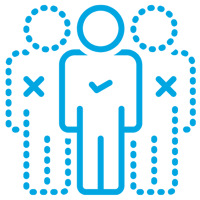For every 13 people currently working in the UK, one person is on long-term sick!
This staggering statistic is unprecedented.
As reported by the BBC, more than two and a half million are not working due to health problems, with detail from the Office for National Statistics (ONS) blaming the rise on an increase in mental health issues in younger people and people suffering back and neck pain, possibly due to home working.
Since the start of the Covid pandemic, there were "well over 400,000 more people outside of the labour market due to ill health," Darren Morgan, director of economic statistics at the ONS, told the BBC's Today Programme.
As well as an increase in mental health conditions and back and neck pains, Mr Morgan said there had also been "an increase in the category that includes post-viral fatigue, so perhaps long Covid having an impact".
So, what can we do about this?
Working from home has obviously exploded in recent years and people have views on both sides regarding productivity and creativity, but, if it is encouraged at all, there are many things that an employer should check to prevent back and neck problems, in fact this is a legal requirement.
Simply sitting on the couch (or even in bed!) shouldn’t really be an option.
Home workers should: -1.png?width=200&height=241&name=Untitled%20design%20(80)-1.png)
- Have a workstation which is clutter free and adequately lit
- Have an ergonomic chair and desk that supports good posture and lumbar support
- Make sure the top of their computer screen is level with the eyes and about an arm's length away
- Should be able to relax their shoulders when typing and keep your elbows at 90 degrees
- Take regular breaks too to stand up, stretch and move around.
- Be encouraged that if they have neck or back pain to see a doctor or see a physiotherapist.
But it’s not just about the home workers we need to understand how absence is affecting the workforce as a whole. What is happening, and how we can act to counter any issues. And in this context, absence management software emerges as a powerful tool that can streamline and optimise the process of managing employee absences, leading to improved productivity, reduced costs, and enhanced employee well-being.
Long-term sickness absences can have a detrimental impact on businesses of all sizes.
Apart from the direct financial implications, such as paying for sick leave, backfilling with overtime, or hiring temporary replacements, there are several other indirect costs. These include decreased productivity, disrupted work schedules, increased workloads on other employees and potential damage to employee morale and engagement.
How absence management software works
 Absence management software is a comprehensive solution that automates and simplifies the process of managing employee absences. It typically includes features such as employee self-service portals, absence tracking and reporting tools, leave request approvals, and integration with payroll systems. By leveraging advanced algorithms and data analytics, this software enables organisations to effectively monitor, analyse and mitigate long-term sickness absences.
Absence management software is a comprehensive solution that automates and simplifies the process of managing employee absences. It typically includes features such as employee self-service portals, absence tracking and reporting tools, leave request approvals, and integration with payroll systems. By leveraging advanced algorithms and data analytics, this software enables organisations to effectively monitor, analyse and mitigate long-term sickness absences.